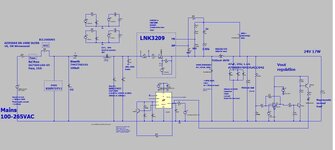cupoftea
Advanced Member level 5
Hi,
Why is this attached Buck deemed to be so bad? (100-265VAC input)
The LNK3209 is run within its current and voltage rating.
The inductor is within ratings.
The SiC diode within ratings.
The circuit will have loads of blown air over it all the time.
So why is it deemed a no-go'er?
LTspice and jpeg attached
LNK3209
Sorry forgot to say vout = 24V, 17W
Why is this attached Buck deemed to be so bad? (100-265VAC input)
The LNK3209 is run within its current and voltage rating.
The inductor is within ratings.
The SiC diode within ratings.
The circuit will have loads of blown air over it all the time.
So why is it deemed a no-go'er?
LTspice and jpeg attached
LNK3209
--- Updated ---
Sorry forgot to say vout = 24V, 17W
Attachments
Last edited:

